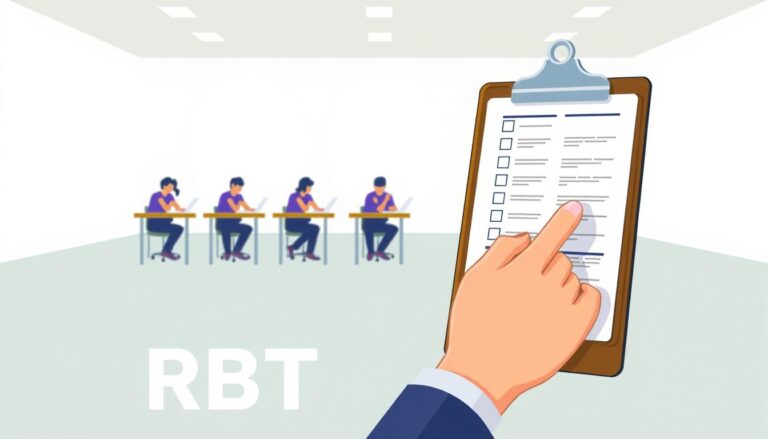What is RBT Therapy & Benefits
Looking into RBT therapy shows its key role in applied behavior analysis (ABA). It helps people with behavioral issues, often seen in autism spectrum disorder. This method uses proven techniques to improve life quality for those it helps.
We will explore what RBT therapy is, the roles of RBTs, and its many benefits.
What is RBT Therapy?
Registered Behavior Technicians (RBTs) are key in applied behavior analysis therapy. They deliver interventions aimed at solving behavioral issues and skill gaps. This is mainly for people with autism. RBTs make sure clients get therapy that fits their needs and works well.
Definition and Overview
RBT therapy is a method that improves specific behaviors and skills. Technicians follow detailed plans and track progress closely. They need to understand behavior therapy well to help clients.
Role in ABA Therapy
In ABA, RBTs are vital for implementing specific interventions. They work with Board Certified Behavior Analysts (BCBAs) to use proven techniques. Their main job is to collect and analyze data, helping to see how clients are doing.
Key Responsibilities of an RBT
RBTs have many tasks to improve a client’s life through therapy. These include:
- Delivering one-on-one behavior intervention as per individualized plans.
- Monitoring and recording client behaviors meticulously.
- Implementing positive reinforcement strategies to encourage desirable behavior.
- Assisting in the development of social, academic, and daily living skills.
By doing these tasks, RBTs are key in applied behavior analysis therapy. They help make lasting changes in behavior.
How to Become an RBT
Starting a career as a Registered Behavior Technician (RBT) requires several important steps. You need to meet training requirements and learn essential skills. Knowing the process can help you succeed.
Training Requirements
The first step is a 40-hour training course. It teaches you about behavior analysis, interventions, and data collection. The training must follow the Behavior Analyst Certification Board (BACB) guidelines.
Certification Process
After training, you must pass a competency assessment. A certified analyst will check your practical skills. Then, you take the RBT exam to show your knowledge and skills.
Skills Needed for Success
Being an RBT requires patience, detailed observation, and strong communication. Patience helps when dealing with challenging behaviors. Good observation skills are key for accurate data. Strong communication ensures teamwork and collaboration.
The Importance of RBTs in Autism Therapy
Registered Behavior Technicians (RBTs) are key in autism therapy. They use proven methods to help improve behavior and make positive changes in people with autism.
Impact on Behavioral Development
RBTs use Applied Behavior Analysis (ABA) and other techniques to tackle bad behaviors. They also help people learn new skills. This hands-on therapy is vital for helping clients develop better behaviors and grow.
Support for Families
RBTs help families too. They work with caregivers to make sure therapy methods are used at home. This helps create a better environment for growth and learning.
Team Collaboration
Good autism therapy needs a team effort. RBTs team up with Board Certified Behavior Analysts (BCBAs), teachers, and other health experts. Together, they create detailed plans that meet the client’s needs. This teamwork makes therapy more effective and precise.
| Role | Responsibilities | Impact |
|---|---|---|
| RBTs | Implement intervention strategies | Reduce problematic behaviors, increase skills |
| Families | Collaborate with RBTs, integrate strategies at home | Create a consistent, supportive environment |
| Team Members | Work with RBTs for holistic plans | Enhance overall therapy effectiveness |
Benefits of RBT Therapy
RBT therapy helps improve many areas of clients’ lives. It brings positive changes that families notice and appreciate.
Positive Behavioral Changes
RBT therapy leads to better behaviors. Clients learn new ways to act and think. This makes them more independent and accepted by others.
Skill Development
Learning new skills is a big part of RBT therapy. Clients get better at everyday tasks and social interactions. This lets them do things on their own, improving their life and activities.
Quality of Life Improvements
The main aim of RBT therapy is to make life better for clients and their families. It fixes behavioral problems and boosts skills. This leads to happier homes and less stress for everyone.
Work Settings for RBTs
Registered Behavior Technicians (RBTs) can work in many places. This lets them use the best strategies for their clients.
In schools, RBTs work with teachers to help students who need extra support. They help early and keep an eye on things all day.
In clinics and hospitals, RBTs team up with BCBAs to help people with developmental disorders. They make sure the therapy is structured and supportive.
Working in private homes, RBTs can work closely with families. This approach makes therapy more effective and consistent.
RBTs can make a big difference in many settings. They provide great support and help their clients make big strides.
Comparison: RBT vs ABA Therapist
It’s important to know the differences between an RBT and an ABA therapist. They work together but have different roles and needs. Their education and what they can do also vary a lot.
Differences in Roles
RBTs mainly carry out plans made by BCBAs. They work with clients to improve their behavior. On the other hand, ABA therapists, who are BCBAs or BCaBAs, create these plans. They also do assessments and check if the plans work.
Educational Requirements
The education needed for RBTs and ABA therapists is different. To be an RBT, you need a 40-hour course, pass a test, and meet other BACB rules. ABA therapists need a master’s or doctoral degree and supervised hours.
Scope of Practice
RBTs focus on doing the work of behavior-analytic services with supervision. They carry out plans and track client progress. ABA therapists, with their broader role, design plans, do research, and supervise RBTs.
Career Advancement Opportunities for RBTs
For those in the RBT career, many avenues for growth and RBT career advancement exist. Continuous professional development is key to enhance skills and open doors to higher roles in Applied Behavior Analysis.
Registered Behavior Technicians can pursue advanced certifications like the Board Certified Assistant Behavior Analyst (BCaBA) or Board Certified Behavior Analyst (BCBA). These roles require more education and rigorous board certification but offer significant career growth. Professional development for RBTs doesn’t stop at certification; ongoing opportunities include specialized training programs, workshops, and courses tailored to enhance expertise in areas like autism therapy, behavior intervention planning, and data analysis.
A solid framework for RBT career advancement also includes mentorship and supervision. Engaging with experienced BCBAs can provide valuable guidance, practical insights, and support for navigating the complexities of ABA therapy. These mentorship experiences are often critical for professional development and can help aspiring BCBAs and BCaBAs gain the necessary skills and confidence to succeed in more advanced roles.
Also, involvement in professional organizations such as the Behavior Analyst Certification Board (BACB) can offer networking opportunities, access to cutting-edge research, and additional resources tailored to the professional development of behavior technicians. Membership in such organizations keeps RBTs updated on the latest industry standards and practices, which is essential for those aiming for RBT career advancement.
Challenges Faced by RBTs
Registered Behavior Technicians (RBTs) face many challenges in their work. They deal with problem behaviors and the need for constant learning. This role demands flexibility and strength.
Managing Problem Behaviors
Handling behavioral challenges is key for RBTs. They must use effective strategies to tackle complex behaviors. This ensures each session leads to positive change.
Continuous Learning and Adaptation
The field of Behavior Analysis is always changing. RBTs need to keep learning to stay up-to-date. This helps them manage behavioral challenges better.
Emotional and Physical Demands
The job of an RBT is emotionally and physically demanding. They work with intense behaviors and face tough issues. It’s important for them to take care of themselves and get support from their supervisors.
How Families Can Benefit from RBT Therapy
Registered Behavior Technicians (RBTs) offer big benefits to families. They help not just the person with autism but also their family. RBTs give parents and caregivers the tools to handle behavioral issues at home.
This leads to a more peaceful home life. Families learn how to use therapy in their daily routines. This training makes their home a stable and supportive place.
RBTs also support families by including them in therapy. They keep the lines of communication open. This way, families know what’s happening and how they can help.
This support makes families feel more in control. They can better support their loved one’s growth. RBT therapy is more than just helping one person; it helps the whole family.
It teaches families how to manage behaviors and use therapy in daily life. This creates a positive and supportive environment for everyone’s well-being.
Conclusion
The role of a Registered Behavior Technician (RBT) is key in ABA therapy, helping those with autism. RBTs get trained and certified to do their job well. They learn how to use behavioral interventions.
The work of RBTs has a big behavioral therapy impact. It helps not just the clients but also their families and communities. RBTs do important tasks like following treatment plans and checking on clients’ progress.
Looking at RBT therapy, we see how vital these professionals are. They help improve the lives of many. This shows how important their work is in ABA therapy.
If you’re starting or already in the RBT field, know your work matters a lot. You can check out our RBT mock exams and guides to help you grow in your career.
FAQ
What is RBT Therapy?
RBT therapy is a type of ABA that focuses on helping individuals, often those with autism. It aims to reduce bad behaviors and help them learn new skills.
What does an RBT do in ABA Therapy?
RBTs carry out plans made by certified analysts in ABA therapy. They track progress, collect data, and help with therapy.
What are the key responsibilities of an RBT?
RBTs follow plans, track data, and work with families and teams. They make sure therapy fits into daily life.
What are the training requirements to become an RBT?
To be an RBT, you need a 40-hour course and pass a test supervised by a certified analyst.
What is the certification process for RBTs?
After the 40-hour course, you take the RBT exam. The Behavior Analyst Certification Board (BACB) administers it. Passing gets you certified.
What skills are needed for success as an RBT?
Good RBTs are patient, observant, and communicate well. They work well with clients, families, and teams.
How do RBTs impact behavioral development in autism therapy?
RBTs work directly with clients. They use strategies to lessen bad behaviors and help learn new skills. This greatly improves behavior.
How do RBTs support families?
RBTs teach families how to handle behavioral issues. They help integrate therapy into daily life.
What is the role of team collaboration for an RBT?
RBTs team up with analysts, educators, and healthcare providers. Together, they create a complete therapy plan.
What are the benefits of RBT therapy?
RBT therapy leads to better behavior, skill development, and a better life for clients.
In what settings can RBTs work?
RBTs work in schools, healthcare, and homes. They tailor therapy to meet client needs.
What are the differences between an RBT and an ABA therapist?
RBTs work under supervision, ABA therapists can work alone. RBTs need a 40-hour course, ABA therapists need degrees and more training.
What are the career advancement opportunities for an RBT?
RBTs can become BCaBA or BCBA with more education and certification. They also have ongoing training options.
What challenges do RBTs face?
RBTs deal with tough behaviors, need to keep learning, and face physical and emotional demands from client work.
How can families benefit from RBT therapy?
Families learn to manage behavior, leading to a better home environment. This improves life for everyone in the family.




